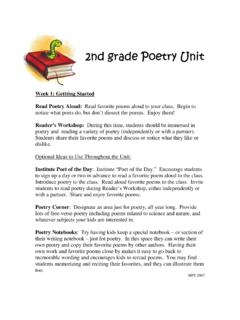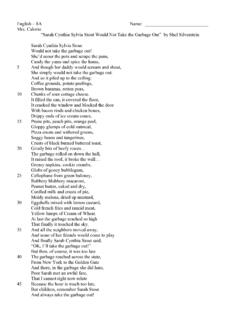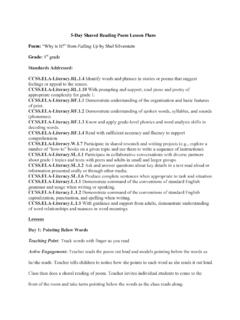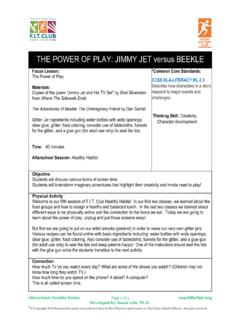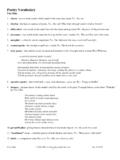Transcription of Professional Development Course 2009 2010 V. …
1 Professional Development Course 2009 2010 V. Pritchard Catering for Learner Diversity in English Language Teaching The copyright of these materials belongs to the orginal authors. We are grateful to them for granting us the right to share the materials with other teachers. Please fully acknowledge the source of the materials and the authors. 1 Module: Short Stories Unit: The Giving Tree Target Group: All classes of Form 1 students Background: Student Profile Our school is a Band 3 school with students from lower and middle income family backgrounds. Within each class there is at least 1 if not 2 or 3 SEN students and there is no extra support in terms of man power. In the past few years more and more mainland students have started to study at our school as well so there are normally 1 or 2 students new to Hong Kong and Concordia. Depending on where the students come from the Mainland, their English levels might be higher or lower than our own school s students.
2 Within a Form 1 class, students English level abilities have a great range. Some students are able to converse in simple conversation with me while others don t even know how to read high frequency words. Class Structure After taking this Course , I realize that despite our schools efforts to use cooperative learning as a way to cater for learning diversity, we actually need to rethink how we are catering to our students English abilities. In the coming school year, I hope that our school will divide all 3 English classes in at least Form 1 and Form 2 into 3 groups according to their English level abilities. If that is not possible, the regular English teacher and I will use my two Language Arts lessons each week to divide the class into 2 separate groups according to students English level abilities. Since at the beginning of the school year grouping will be made according to our school s formal entrance exams results, the grouping will be flexible allowing for movement of students into either groups after more informal and formal assessment has taken place.
3 Rationale: I am fortunate to teach each Form 1 class a language arts lesson twice a week. Our school has a five day schedule and classes meet for 55 minutes each. After we have finished a unit called Getting to know you and a poetry unit, we will introduce the short story of The Giving Tree. Generally, we will have four to five 55 minute lessons to allocate for this unit. One or two activities may be used in a lesson according to how much time the class needs for each activity. I chose The Giving Tree because it uses a lot of high frequency words and the other vocabulary words are not too difficult for students to learn and most have a common context of trees. The story is easy to understand even without the text, therefore, students are able to use the pictures to help them understand and remember new vocabulary words. This story is very good for introducing the elements of a story as the story line is simple.
4 I use this unit as the beginning of our scaffolding for students knowledge, use and application of the elements of a story building up to the School Based Assessment (SBA) in Form 4 and 5. Also, since The Giving Tree has a simple storyline, students enjoy the story as it is quite meaningful, and it is easy to apply to their lives. Concept/ Attitude Enhanced: I found this Course quite useful, and I learned that although I have already been using ways to cater for students learning abilities and multiple intelligences, it wasn t always intentional or enough. Through the examples we studied in class, I have a better understanding of what types of tasks can cater for multiple intelligence, and I appreciate more how this could help motivate students to learn. Professional Development Course 2009 2010 V. Pritchard Catering for Learner Diversity in English Language Teaching The copyright of these materials belongs to the orginal authors.
5 We are grateful to them for granting us the right to share the materials with other teachers. Please fully acknowledge the source of the materials and the authors. 2 My Application of gained knowledge from Catering for Diversity Course : In this unit, I have tried to include tasks using a variety of multiple intelligences. Also, I have modified all of the materials to cater to the lowest and highest English Language Level groups.* Modification might include providing extra vocabulary in English and/or Chinese, giving simpler directions, giving more sentence starters/ patterns, using different types of tasks (matching vs. chart completion) and adjusting the amount of language input, language output or task completion. Also, the instructional strategies will include whole class teaching, individual, partner and group work. * (I prefer to categorize my students as beginners, intermediate beginners, advanced beginners etc.)
6 , as I feel that this labeling does not affect their self-esteem and confidence as much other labels. Most students realistically know which English language level they belong to because they themselves know how many lessons or Course they have taken, how much exposure to English they have had, how much they have used their English and how they compare to their classmates. I would hope that the level they are grouped in is more justifiable to them. Whereas I feel stronger/ weaker or elite / remedial carry negative connotations lowering their motivation level to learn English.) Overview of Unit: Activity 1 Pre-Reading Tasks - Knowledge / Evaluation Building Vocabulary (Visual) Prediction (Logical) Activity 2 Reading the story YouTube video (Linguistic/ Musical) Reading the text of the story (Linguistic) (L3 only) Activity 3 Revision of Related Vocabulary Matching Task (Visual) L1 Vocabulary Flash Cards (Linguistic/ Visual) Unit Overview - Continued Activity 4 - Post Reading Tasks - Comprehension / Application Comprehension task (Logical) Comparing Characters (Logical) Application to students relationships/ lives (Intrapersonal) Professional Development Course 2009 2010 V.
7 Pritchard Catering for Learner Diversity in English Language Teaching The copyright of these materials belongs to the orginal authors. We are grateful to them for granting us the right to share the materials with other teachers. Please fully acknowledge the source of the materials and the authors. 3 Activity 5 - Teaching Vocabulary Elements of a story ** Activity 6 Elements of a story - Analysis Story Map (Kinesthetic) Activity 7 Evaluation Elements of a story - Theme (Logical) Activity 8 - Extension Activity (Linguistic/ Interpersonal) ** Activity 9 Dramatization Reader s Theater (Interpersonal / Kinesthetic) Activity 10 - Book Report (Linguistic) Objectives: Teacher: 1. Make use of the authentic material, The Giving Tree 2. Arouse students interest in learning English 3. Incorporate language arts in the English curriculum 4. Give students opportunities to use English as a means of communication 5.
8 Initiate dialogue among students 6. Introduce elements of a story and apply them to story Student: 1. Make story prediction 2. Listen to authentic English 3. Describe the characters 4. Identify the elements of a story and apply to story 5. Discuss the main theme(s) of the story 6. Evaluate their relationship with family/ teachers/ friends 7. Recite lines from The Giving Tree in the form of a reader s theater 8. Evaluate students reading performance Summary of The Giving Tree: This story is about a tree and a boy. In the beginning of the story, the boy and the tree play together every day, and they love each very much. When the boy starts to grow up, he still likes to be near the tree, but this time he is with his girlfriend. As he starts to grow up, the boy only comes to visit the tree when he needs something. At different stages of his life he asks for money, a house, a boat and a place to rest.
9 Each time the tree provides for his needs until she has nothing left. Although we are told that the tree is happy to see the boy each time and provide for his needs, we are left to wonder whether the tree is really happy or not. Professional Development Course 2009 2010 V. Pritchard Catering for Learner Diversity in English Language Teaching The copyright of these materials belongs to the orginal authors. We are grateful to them for granting us the right to share the materials with other teachers. Please fully acknowledge the source of the materials and the authors. 4 References: (In order of use.) (Story Book) silverstein , S (1997). The Giving Tree. New York: Harper Collins. (You Tube Videos) Hamil Kate, (Sept 23, 2008) The Giving Tree 2008, [video], Retrieved June 22, 2011, from MickelTrickel , (Jun 10, 2007), The Gift of The Giving Tree, [video], retrieved June 22, 2011, from silverstein , S (Apr 10, 2008 ) The Actual '73 Giving Tree Movie Spoken By shel silverstein [video], retrieved June 22, 2011, from (Vocabulary Revision Activity 3 Level 1 Worksheet) Simelmits, Betty, English Exercises - Readings exercises -The Giving Tree.
10 English Exercises. Retrieved on June 14, 2011 from (Reader s Theater script) Young, Chase. (2011). Reader s Theater Scripts. Mr. Young s Class Reader s Theater. Retrieved on June 23, 2011 from Procedures: Activity 1: Pre reading Tasks Materials: Worksheets Comprehension Strategy: Previewing and Predicting Professional Development Course 2009 2010 V. Pritchard Catering for Learner Diversity in English Language Teaching The copyright of these materials belongs to the orginal authors. We are grateful to them for granting us the right to share the materials with other teachers. Please fully acknowledge the source of the materials and the authors. 5 Bloom s Taxonomy: Knowledge / Evaluation Multiple Intelligences: Visual and Logical Catering for Learning Diversity: Level 1 Students can use Chinese meaning to understand the meaning of the words.

